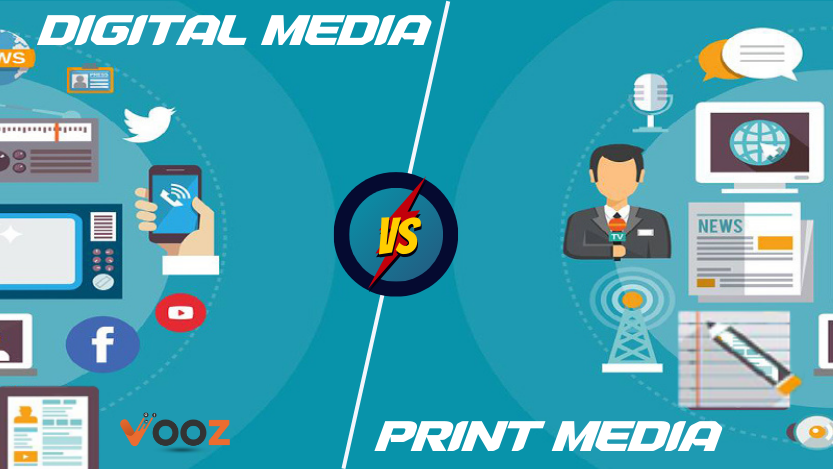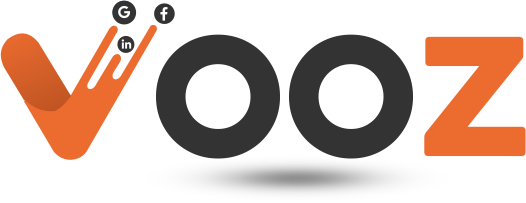
In the ever-evolving realm of media, the shift from print to digital media has transformed the way information is consumed and disseminated. It has changed the whole medium of distribution and exchange, and made it more efficient and easy going.
Whereas print media, with its long-standing history, and digital media, with its rapid rise in popularity, offer distinctive advantages and disadvantages. They have their own sets of advantages as well as disadvantages for the marketing realm out there.

So here in this article delves into the key differences between these two mediums and explores their impact on audience engagement, reach, revenue models, and more.
Also read
Mastering Email Marketing in 2023: Simple Steps with Vooz Tech
Evolution of Media Landscape: Print to Digital Media
Print media has a rich legacy and has been a primary source of news, information, and entertainment for centuries. Newspapers, magazines, and books have served as trusted companions, offering a tactile experience and a sense of permanence. People are attached to the services of print media that they have been offered with from ages.

On the other hand, digital media emerged with the advent of the internet, revolutionising the way content is created, consumed, and shared. Websites, blogs, social media platforms, and digital publications have gained immense popularity, providing instant access to a vast array of information.
Tangibility vs. Accessibility: Print to Digital media
One of the fundamental differences between print and digital media lies in their physicality. Print media offers a tangible experience that engages multiple senses. The feel of paper, the sound of pages turning, and the smell of ink evoke a unique sensory connection. It makes people concentrate on the content mentioned, and to seek the details of the matter.
Also read
5 Effective Email Marketing Strategies to Increase Open and Click Rates

In contrast, digital media provides accessibility and convenience. With just a few clicks, users can access information on various devices, enabling seamless reading experiences anytime, anywhere. Moreover, this media allows for multimedia integration, incorporating videos, images, and interactive elements to enhance content delivery.
Audience Engagement: Passive vs. Interactive
Print media traditionally adopts a passive consumption model, where readers absorb information without active participation. Readers engage in a linear reading experience, flipping through pages and absorbing content at their own pace.

On the other hand, digital media encourages interactivity and user engagement. Comment sections, social media sharing, and real-time feedback mechanisms enable readers to actively participate, express opinions, and engage in discussions with content creators and other users. This two-way communication fosters a sense of community and enhances the overall reading experience.
Reach and Impact: Local vs. Global Perspectives
Print media has historically catered to localised audiences, with newspapers and magazines serving specific regions or communities. While this localised focus allows for targeted content delivery, it limits the reach and impact of the information, and makes it fragile in the modern world.
Also read

Digital media, on the other hand, transcends geographical boundaries and provides a global platform for content dissemination. News articles, blog posts, and multimedia content can be shared instantly with audiences worldwide, fostering cross-cultural understanding and enabling diverse perspectives to be heard.
Revenue Models: Traditional vs. Innovative Approaches
Print media has long relied on traditional revenue models, such as subscriptions, advertisements, and newsstand sales. However, the digital revolution has challenged these models, giving rise to innovative approaches.
Digital media offers diverse monetization strategies, including paywalls, sponsored content, affiliate marketing, and crowdfunding. Additionally, this media platforms provide valuable data analytics, enabling content creators to understand their audience better and deliver targeted advertisements.

This shift in revenue models has transformed the media industry’s economic landscape, presenting both opportunities and challenges, and has also been beneficial in the way of exchange and business in the 21st century.
Also read
Print to Digital media: Conclusion
In the end, print and digital both have their own pros and cons that determines their effectiveness and flaws in the real world. But in the case of the modern world, the most effective way of connecting is the use of digital platforms.
They are advanced, less damaging, and highly resourceful for any individual out there. It provides detailed information about the topic, and also relays your ideas with better engagement to the world. So indulge in the practices of digital marketing, and get the best for yourselves.
About Our Company
Vooz Tech is the perfect solution for all the businesses out there seeking help with their best digital and digital marketing company in Dubai . We provide the best team at your services to look after your ranking in the search engine, and help elevate it further. We are all set to work for you. But the question is are you?
Frequently Asked Questions
Yes, print media is still effective and intact for many purposes out there. But comparing its effectiveness from that of digital media makes no sense, as both have different technologies and approaches from the very start.
This media has transformed journalism by enabling real-time reporting, interactive storytelling, and multimedia integration, while also presenting challenges like the spread of misinformation.
Digital media platforms offer the most cost-effective options for all the advertisers out there, and also provide better engagement and conversions for those advertisements.
No, print media has its own set of applications that can never be fulfilled by any digital platform, continuing its existence in the modern world too.





